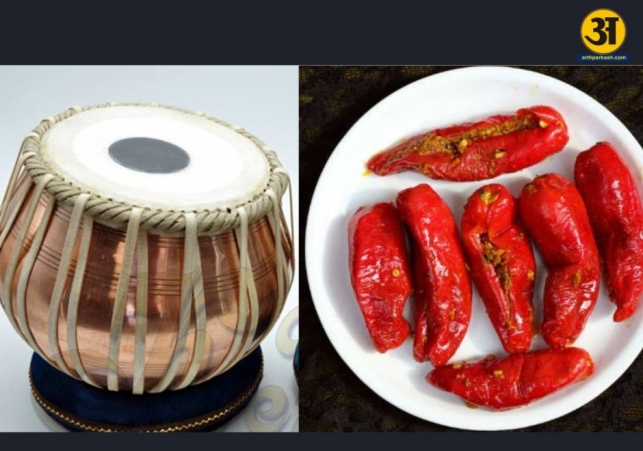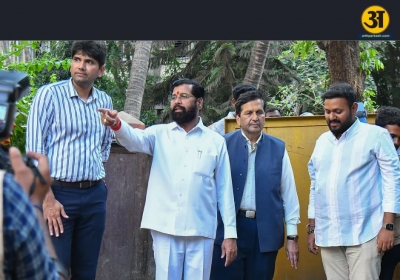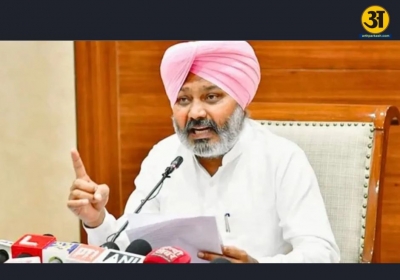
PM Modi gives GI tags to 21 items, Banarasi tabla on list
PM Modi presents GI certificates to 21 products including Banarasi tabla and Bharwan mirch
During his visit to Varanasi on Friday, Prime Minister Narendra Modi gave Geographical Indication (GI) certificates to 21 traditional products from Uttar Pradesh. This important event celebrates the state’s unique culture and heritage. Among the new GI-tagged items are Banarasi Tabla and Banarasi Bharwan Mirch, both famous in the region.
The GI tag means that a product is linked to a specific place and has special qualities or reputation because of that location. It also helps protect the product's identity and gives recognition to the people who make it. Now with 77 GI-tagged items, Uttar Pradesh has become India’s number one state in terms of GI-certified products.
The Kashi region alone has received 32 GI tags, making it a major center for such special products not just in India, but across the world. This shows how rich and diverse the region’s culture, craft, and food really are.
The event also highlighted the success of the ‘One District, One Product’ (ODOP) scheme started by the Yogi Adityanath government. This scheme supports local craftspeople and small industries by focusing on one famous product from each district. It helps these items get national and even international attention.
Many Varanasi items get GI tag
During the ceremony in Varanasi, several well-known products from the area were awarded GI certificates. These include:
-
Banarasi Shehnai – a traditional musical instrument.
-
Metal casting craft – a historic method of making metal objects.
-
Mural painting – wall art that has cultural stories.
-
Lal Peda – a sweet made with milk.
-
Thandai – a special drink made with milk and spices.
-
Tirangi Barfi – a tricolour sweet.
-
Karonda from Chiraigaon – a sour fruit known for its taste.
All these items are now officially protected with a GI tag. This means that only people from the region who make these products in the traditional way can use the name. This helps avoid copycats and gives real artisans the recognition they deserve.
GI Tag means new opportunities
These GI tags are more than just a name. They help people in many ways. For example:
-
Artisans and farmers get better prices for their products.
-
Buyers know they are getting the real, authentic item.
-
Small businesses can grow and reach international markets.
-
Local culture is preserved and celebrated.
According to Dr Rajnikant, a GI expert and Padma Shri awardee, the Kashi region is now the “world’s GI hub.” With 32 GI products, the area supports around 20 lakh people and brings in a yearly business of ₹25,500 crore.
This means that these traditional crafts are not only a part of culture but also a big part of the economy. Thousands of families depend on them for their income.
ALSO READ: UP government approves hike in daily allowance for PRD personnel
More unique products from across the State
Apart from Varanasi, many other regions in Uttar Pradesh also received GI tags for their special products. Some of these are:
-
Bareilly’s furniture – known for its strong build and artistic designs.
-
Bareilly’s zari-zardozi work – beautiful embroidery with gold and silver threads.
-
Bareilly’s terracotta – artistic clay items.
-
Mathura’s Sanjhi craft – traditional paper cutting art with religious designs.
-
Bundelkhand’s Kathiya wheat – a special kind of wheat grown in the area.
-
Pilibhit’s bamboo flute – famous musical instrument made by skilled hands.
-
Chitrakoot’s wood craft – decorative wooden items made by local artisans.
-
Agra’s stone inlay work – beautiful marble designs similar to those seen in the Taj Mahal.
-
Jaunpur’s Imarti – a sweet made in a special circular shape.
These products all represent the rich identity of their respective regions. With the GI tag, they are now legally protected. This stops fake versions from being sold and helps protect the traditional skills of the people who make them.
A Geographical Indication (GI) tag tells people that a product is authentic, has a history, and belongs to a specific region. It helps promote local culture and traditions in a global market. When a product gets a GI tag, it also brings pride to the community that creates it.
More importantly, it helps local artisans and farmers to:
-
Earn better income.
-
Protect their knowledge and skills.
-
Keep their traditional methods alive.
-
Expand into national and global markets.
For example, a Banarasi Tabla or Bharwan Mirch can now be marketed as a premium product from a specific region. International customers often prefer products with GI tags because they know they are original and high-quality.
GI tags also create jobs. As demand for these products grows, more people can get involved in making, packaging, and selling them. This helps reduce unemployment and boosts the rural economy.
The ODOP (One District, One Product) scheme has been very successful in Uttar Pradesh. It aims to promote local entrepreneurship by focusing on one well-known product from each district.
With the GI certificates now given to many ODOP items, the scheme gets even stronger. It helps in:
-
Getting government support for artisans.
-
Finding new buyers for their products.
-
Getting easier access to loans and training.
-
Organising fairs and exhibitions to show off their work.
By connecting traditional skills with modern marketing and support, the scheme is creating new success stories across the state.
International recognition and legal rights
When a product gets a GI tag, it is not just a label. It comes with legal protection under Indian law. No one else outside the region can use the same name for their product. This prevents the market from being flooded with fake versions.
Also, once a product is GI-certified in India, it can be registered internationally. This opens the doors to global markets, where people are willing to pay a premium for genuine and traditional items.
For example, Banarasi Sarees are already famous around the world. Now with more products like the Banarasi Tabla and Bharwan Mirch being added, international buyers will start noticing these too.
This helps build India’s soft power – a way of showing the world its rich culture, heritage, and craft.
Prime Minister Narendra Modi’s move to give GI certificates to 21 traditional products from Uttar Pradesh is a major boost to local culture and economy. The Banarasi Tabla and Bharwan Mirch are just two examples of how local traditions are being recognised and protected.
With a total of 77 GI-tagged items, Uttar Pradesh leads the country. The Kashi region alone has 32 GI tags, making it the world’s GI hub. From sweets and drinks to crafts and musical instruments, every product tells a story of tradition, skill, and pride.
The GI tag not only protects these items legally but also helps artisans get better prices, reach bigger markets, and find new work opportunities. With continued support from the government and awareness from the people, these traditional treasures will now shine brighter on the global stage.





